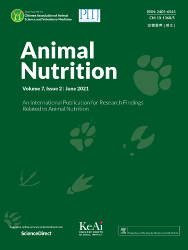Mixed organic acid alternative to antibiotics improves serum biochemical parameters and intestinal health of weaned piglets
Animal Nutrition Journal, https://doi.org/10.1016/j.aninu.2020.11.018.
- Swine
- Open Access
- Piglets

Abstract
The primary aim of this experiment was to critically explore the relationship between the different levels of mixed organic acids (MOA) and growth performance, serum antioxidant status and intestinal health of weaned piglets, as well as to investigate the potential possibility of MOA alternative to antibiotics growth promoters (AGP). A total of 180 healthy piglets (Duroc × [Landrace × Yorkshire]; weighing 7.81 ± 1.51 kg each, weaned at d 28) were randomly divided into 5 treatments: 1) basal diet (CON); 2) CON + chlorinomycin (75 mg/kg) + virginiamycin (15 mg/kg) + guitaromycin (50 mg/kg) (AGP); 3) CON + MOA (3,000 mg/kg) (OA1); 4) CON + MOA (5,000 mg/kg) (OA2); 5) CON + MOA (7,000 mg/kg) (OA3). This study design included 6 replicates per treatment with 6 piglets per pen (barrow:gilt = 1:1) and the experiment was separated into phase 1 (d 1 to 14) and phase 2 (d 15 to 28). In phases 1, 2 and overall, compared with the CON, the feed conversion ratio (FCR) was reduced (P < 0.01) and the average daily gain (ADG) was increased (P < 0.05) in piglets supplemented with AGP, OA1 and OA2. The concentration of serum immunoglobulins G (IgG) was improved (P < 0.05) in piglets supplemented with OA2 in phase 2. In the jejunum and ileum, the villus height:crypt depth ratio was significantly increased (P < 0.01) in piglets fed AGP and OA1. The mRNA expression level of claudin-1 and zonula occludens-1 (ZO-1) (P < 0.01) was up-regulated in piglets supplemented with OA1 and OA2. The piglets fed AGP, OA1 and OA2 showed an increase (P < 0.05) in the content of acetate acid and total volatile fatty acids (TVFA) in the cecum, and butyric acid and TVFA in the colon compared with CON. Also, OA1 lowered (P < 0.05) the content of Lachnospiraceae in piglets. These results demonstrated that MOA at 3,000 or 5,000 mg/kg could be an alternative to antibiotics due to the positive effects on performance, immune parameters, and intestinal health of weaned piglets. However, from the results of the quadratic fitting curve, it is inferred that MOA at a dose of 4,000 mg/kg may produce a better effect.
Acknowledgements
[...]We acknowledge Nutreco Company (Amersfoort Netherland) for providing the new organic acid commercial products [...].